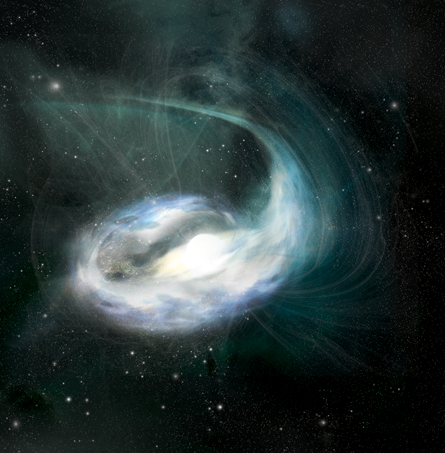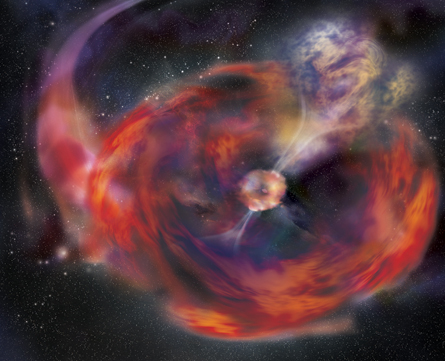The unusually bright and long-lived gamma-ray burst that appeared on December 25, 2010, is an enigmatic holiday gift that isn’t quite unwrapped yet.


After nearly a year, scientists trying to catch the culprit behind the perplexing explosion have arrived at two completely different answers, both presented in the Dec. 1 Nature. One theory involves a small object, such as an asteroid or comet, passing too close to a neutron star and going out in a gamma blaze of glory. The other theory suggests that a gnarly stellar merger — followed by a dim supernova — delivered the bizarre Christmas burst.
Detected by NASA’s Swift satellite, the event lasted much longer than typical gamma-ray bursts, which hurl intense pulses of high-energy gamma rays into space. Weird X-rays and unexpected heat emissions characterized the afterglow, which didn’t fade normally, either. “I have a list of oddball events that we’ve seen with Swift, and this probably tops the list,” says astrophysicist Neil Gehrels of NASA’s Goddard Space Flight Center in Greenbelt, Md., who leads the team managing the Swift satellite. “What I find interesting and amusing is that these are completely different models to explain the same data.”
Christina ThÓne, an astronomer at the Astrophysical Institute of Andalucía in Granada, Spain, says she and her colleagues considered “all kinds of weird theories” before settling on the stellar merger scenario. In that version, a neutron star slowly spirals in toward a massive helium star, eventually colliding and producing a cataclysmic explosion of gamma rays. Then, a faint supernova goes off roughly 10 days later, an event that could explain bumps in the Christmas gamma-ray burst’s fading light curve.
This story of star death would have to have taken place in a galaxy not so far away, but definitely not in the Milky Way. That’s a problem, given that astronomers haven’t been able to unambiguously spy a host galaxy for the Christmas spectacle. Still, astrophysicist Enrico Ramirez-Ruiz of the University of California, Santa Cruz, says he thinks this explanation is the more likely of the two, even though “there are some details that still bother me.”
The second theory, a seemingly cautionary tale of a curious comet’s demise, also required some creative thinking from scientists. Sergio Campana, an astrophysicist at Italy’s Brera Astronomical Observatory in Merate, acknowledges that his team’s version of events sounds “peculiar,” but he says it works. Calculations suggest that if an object half the mass of the dwarf planet Ceres were shredded by a neutron star, it would produce enough debris to trigger a prolonged gamma-ray expulsion. In this version, the burst comes from within the Milky Way.
Gehrels says he was initially inclined toward this explanation, given the apparent proximity of the burst and absence of a host galaxy, but now can’t decide between the two.
And though perhaps peculiar, the idea of small bodies whirling around neutron stars is not new. The first planets observed outside the solar system were found orbiting rapidly spinning neutron stars known as pulsars.
The small body/neutron star explanation fits theories describing how small objects might form around these stars, says Alex Wolszczan, an astronomer at Pennsylvania State University in University Park who studies pulsar planets. The team’s calculations “are not crazy,” he says, but notes that a wandering neutron star capturing minor bodies — one of the team’s considerations — is more in the realm of science fiction.
While scientists might quibble over which scenario best fits the data, most agree that unambiguously resolving where the burst occurred will point toward one explanation or the other. Of course, the burst could still be the product of an even more exotic event, says Ramirez-Ruiz. “I think this object is unique enough that it could certainly be attributed to something we haven’t thought of.”







